
EBR-57 | October 2020
Poison Hemlock (Conium maculatum)
Poison Hemlock (Conium maculatum), is a member of the plant family Apiaceae, which contains a few important crops such as carrots, celery, and parsnips. This poisonous weed is a tall, invasive and highly poisonous weed that is sometimes mistaken for one of its crop relatives. It is also commonly mistaken for Queen Anne's Lace (Daucus carota).
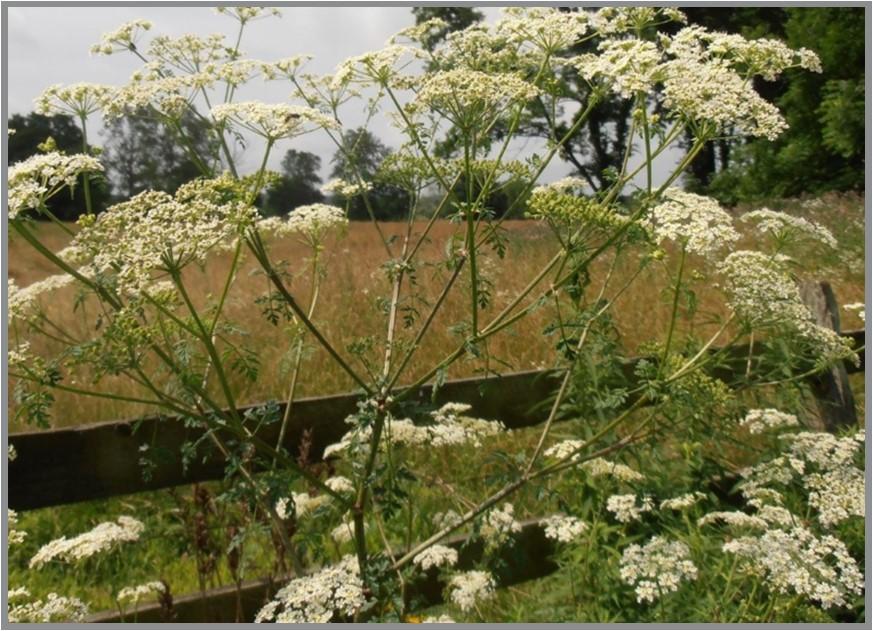
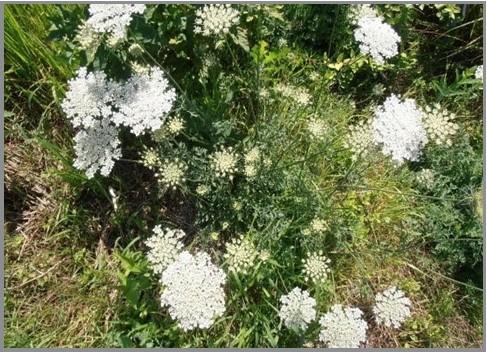
Poison hemlock is an erect biennial (flowering plant that takes two years to complete its life cycle) weed that can grow six to ten feet tall. During the first year, growth is limited to a rosette of dark green leaves. More growth is observed in the second year, where the plant develops branching and alternately arranged leaves on erect stems. This erect plant has smooth, hollow stems that are covered with purple spots. The leaves are pinnately compound (each leaf is made up of several pairs of leaflets), multi-stemmed and fern-like.
During the reproductive stages, the flowers are white umbrella-like clusters that form during June and July, turning to fruit that is small, flat and grayish-green in color from August to September. The root system is a fleshy white, with a long and sometimes branched taproot.
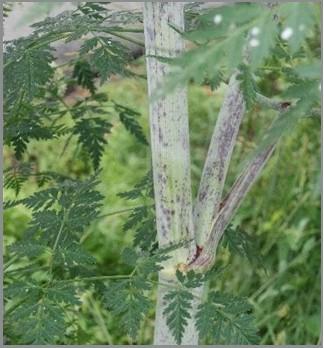

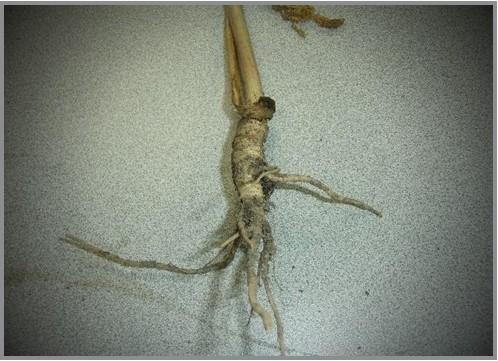
Poison hemlock is an herbaceous (soft stem) plant that reproduces solely by seeds. The seeds separate from the plant when it becomes mature, and despite the plant’s prolific seed production, does not have a mechanism for long distance seed dispersal. The seeds drop close to the parent plant and may be spread over distance by water, birds and rodents and remain viable for only two to three years.
Poison hemlock is native to northern Europe, western Asia and North Africa and it was introduced to North America as an ornamental back in the 1800’s. Over time, this weed has spread throughout America, Mexico and Canada.
Poison hemlock is toxic to humans and to livestock if ingested, by affecting the respiratory, central nervous and reproductive systems. Some humans and animals can experience dermatitis on the skin just by coming into direct contact with this weed due to the potency of the eight alkaloids that contribute to its toxicity. All parts of this plant are poisonous and can be fatal to livestock and humans if ingested.
Poison hemlock grows at low elevations bordering pastures and cropland. This weed grows where moisture is adequate and disturbance of its surroundings is relatively frequent, such as streams, ditches, riparian woodlands and flood plains. Seeds that were carried by flood waters can explain patches of poison hemlock that are found in areas outside the normal water levels.
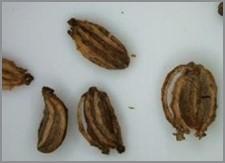
As with any weed specimen that is spread by seed, your best level of defense is to prevent the weed from producing seeds in the first place.
If you have many plants in an area, you may want to make sure that you contain them by pulling the newly established plants by hand (wear gloves), or by hoeing them out. You could also spray an herbicide around the border of that area to prevent the immediate spread of this weed. When you decide to control the larger plants of this area, plan to control them from the ground up. Keep in mind that sap of this plant is toxic. You do not want your skin to come into contact with the sap, and you do not want to burn these plants in case of accidental inhalation by someone or by a near-by animal.
When pulling the plants by hand, the entire taproot needs to be removed from the soil to prevent regrowth. Plowing or repeated cultivation of newly germinated plants can prevent the weed from becoming re-established in the area. If plowing or cultivation is not an option, repeated mowing once the plants have bolted but before they bloom will reduce seed production and can be key to controlling, and even eradicating, a weed infestation.
The act of mowing depletes the energy reserves in the taproot of the poison hemlock, thus weakening its competitive edge, as well as prevents flower and seed formation.
There are several herbicides (e.g. Glyphosate, or 2,4-D) on the market to control poison hemlock, so take care which product you select and make sure that you follow the directions on the label for dosage, application, and what personal protection you should wear during application. Most of these herbicides are going to require you to take action on this weed early in the season when this plant is in a seeding or small rosette stage. This may require you to carefully spot spray the rosette at a given height with the appropriate dosage of the herbicide that you are applying for control. If it is too late for your chemical control measures for this year, start planning your control measures for next year/next season today. Keep in mind that the problem is not going to go away with one application of herbicide; this weed is persistent. You may need to combine mechanical and chemical control for best results, and it may take more than one or two years to control this weed.
DORIS BEHNKE
dbehnke@umd.edu
This publication, Poison Hemlock (Conium maculatum) (EBR-57), is a part of a collection produced by the University of Maryland Extension within the College of Agriculture and Natural Resources.
The information presented has met UME peer-review standards, including internal and external technical review. For help accessing this or any UME publication contact: itaccessibility@umd.edu
For more information on this and other topics, visit the University of Maryland Extension website at extension.umd.edu
University programs, activities, and facilities are available to all without regard to race, color, sex, gender identity or expression, sexual orientation, marital status, age, national origin, political affiliation, physical or mental disability, religion, protected veteran status, genetic information, personal appearance, or any other legally protected class.
When citing this publication, please use the suggested format below:
Behnke, D. (2020). Poison Hemlock (Conium maculatum) (EBR-57). University
of Maryland Extension. go.umd.edu/EBR-57
 English
English العربية
العربية Български
Български 简体中文
简体中文 繁體中文
繁體中文 Hrvatski
Hrvatski Čeština
Čeština Dansk
Dansk Nederlands
Nederlands Suomi
Suomi Français
Français Deutsch
Deutsch Ελληνικά
Ελληνικά हिन्दी
हिन्दी Italiano
Italiano 日本語
日本語 한국어
한국어 Norsk bokmål
Norsk bokmål Polski
Polski Português
Português Română
Română Русский
Русский Español
Español Svenska
Svenska Català
Català Filipino
Filipino עִבְרִית
עִבְרִית Bahasa Indonesia
Bahasa Indonesia Latviešu valoda
Latviešu valoda Lietuvių kalba
Lietuvių kalba Српски језик
Српски језик Slovenčina
Slovenčina Slovenščina
Slovenščina Українська
Українська Tiếng Việt
Tiếng Việt Shqip
Shqip Eesti
Eesti Galego
Galego Magyar
Magyar Maltese
Maltese ไทย
ไทย Türkçe
Türkçe فارسی
فارسی Afrikaans
Afrikaans Bahasa Melayu
Bahasa Melayu Kiswahili
Kiswahili Gaeilge
Gaeilge Cymraeg
Cymraeg Беларуская мова
Беларуская мова Íslenska
Íslenska Македонски јазик
Македонски јазик יידיש
יידיש Հայերեն
Հայերեն Azərbaycan dili
Azərbaycan dili Euskara
Euskara ქართული
ქართული Kreyol ayisyen
Kreyol ayisyen اردو
اردو বাংলা
বাংলা Bosanski
Bosanski Cebuano
Cebuano Esperanto
Esperanto ગુજરાતી
ગુજરાતી Harshen Hausa
Harshen Hausa Hmong
Hmong Igbo
Igbo Basa Jawa
Basa Jawa ಕನ್ನಡ
ಕನ್ನಡ ភាសាខ្មែរ
ភាសាខ្មែរ ພາສາລາວ
ພາສາລາວ Latin
Latin Te Reo Māori
Te Reo Māori मराठी
मराठी Монгол
Монгол नेपाली
नेपाली ਪੰਜਾਬੀ
ਪੰਜਾਬੀ Afsoomaali
Afsoomaali தமிழ்
தமிழ் తెలుగు
తెలుగు Yorùbá
Yorùbá Zulu
Zulu ဗမာစာ
ဗမာစာ Chichewa
Chichewa Қазақ тілі
Қазақ тілі Malagasy
Malagasy മലയാളം
മലയാളം සිංහල
සිංහල Sesotho
Sesotho Basa Sunda
Basa Sunda Тоҷикӣ
Тоҷикӣ O‘zbekcha
O‘zbekcha አማርኛ
አማርኛ Corsu
Corsu Ōlelo Hawaiʻi
Ōlelo Hawaiʻi كوردی
كوردی Кыргызча
Кыргызча Lëtzebuergesch
Lëtzebuergesch پښتو
پښتو Samoan
Samoan Gàidhlig
Gàidhlig Shona
Shona سنڌي
سنڌي Frysk
Frysk isiXhosa
isiXhosa